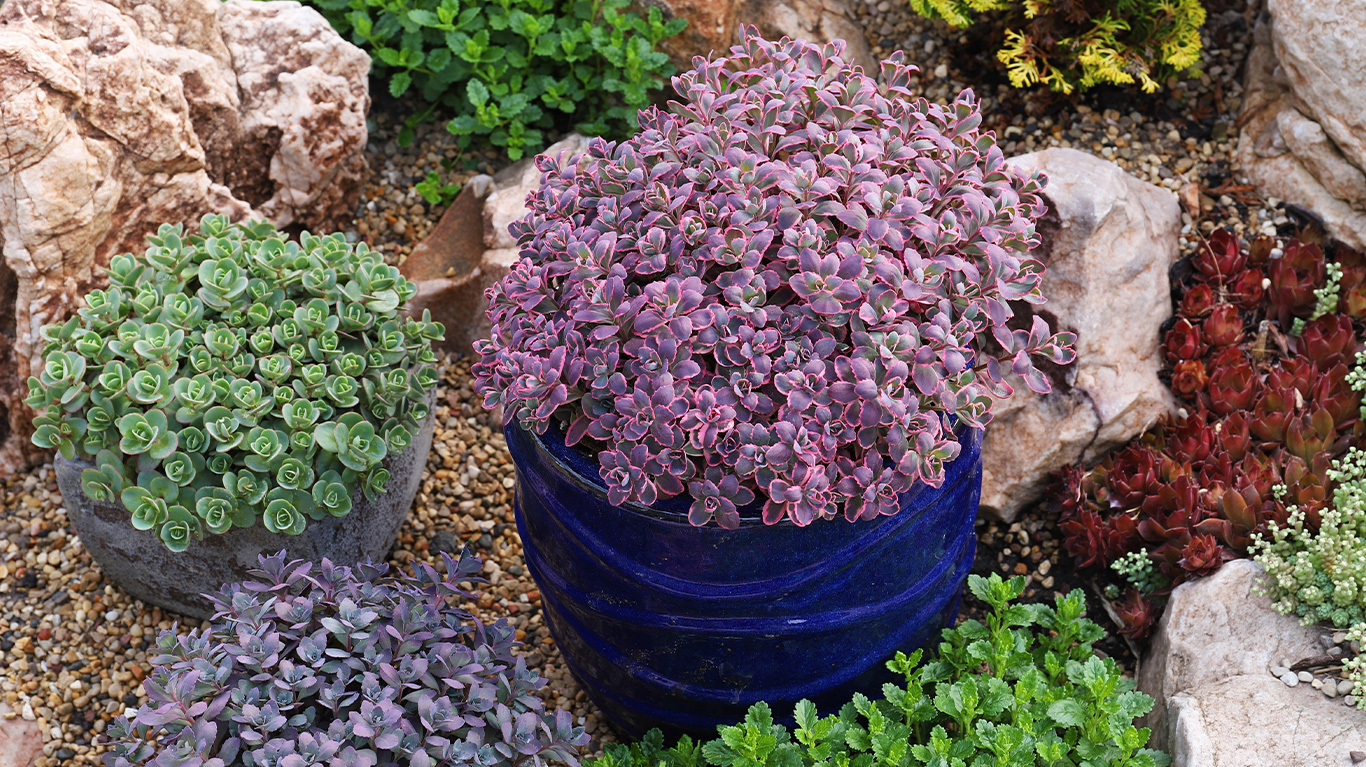
What We've Included
When to Plant | How to Plant | Where to Plant | When to Water | Deadheading | Overwintering | Propagating | Common Issues & How to Solve Them | When do they Flower?
When to Plant
Sedums can be planted in Spring or Autumn, if all danger of frost has passed.

How to Plant
Planting Loose Roots
Loose roots to beginners might sound intimidating but are in fact, incredibly easy to plant! Here’s how to do it:
- Soak roots in a bucket of water for 1-2 hours before planting.
- Dig a hole in the border that’s big enough to house the root system. If planting in pots, fill it halfway with potting soil and then pop the roots in with the crown pointing upwards and the root system pointing to the floor.
- Plant in groups for a fuller display, usually in groups of 3, somewhere that gets plenty of sunlight.
- Ensure the crown is just below the soil unless the plant has some leaves, in which case leave them exposed with the rest of the root system under the soil.
- Water well once planted.
Planting Pot-Grown Plants/Modules
Our pot-grown plants are incredibly easy to plant and grow. Whether you’re growing them directly outside into the border or into a container, our pot-grown plants are a breeze from the moment they arrive.
- Dig a hole in the border that’s big enough to house the root system. If planting in pots, fill a large pot halfway with potting soil and then make a well in the middle. Do this until the top of the soil from the plant is just below the top of the pot.
- Wedge in the plant by adding soil to the gaps in the hole, firming down the surface to ensure it’s in place.
- Water well and you’re done!
Where to Plant
A sunny spot in preferred for Sedum to thrive. Pick a spot at the front of a border or in a container and watch them come to life. These plants are great as ground cover, too, and can mitigate pesky weeds from ruining your hard work.

When to Water
Sedums are drought-tolerant and won’t need much watering. During warm bouts of weather, aim to water them once a week.
Deadheading
You won’t need to deadhead sedums throughout their flowering, but you can cut them back in spring. In February to March, cut back old flowerheads - or, in May, perform a ‘Chelsea Chop’. This is when you cut half of the stems to the ground, which avoids a flop from the middle once summer rolls around.
Overwintering
Sedum, like many perennials, dies back over winter. To help them survive, cut them back to the ground after they’ve finished flowering in mid-autumn. Cover the area with a thick layer of mulch to protect them from frosts.

Propagating
You can propagate Sedum by division. This can be done in autumn or spring, preferably once they’ve finished flowering if you choose to divide them in autumn. The division helps to decongest large clumps that have gotten a bit too wild over a few years of growth. To divide sedums, lift it out of the ground gently, trying not to damage the roots, and split clumps with a spade.
Sedums can also be propagated by taking cuttings from the main plant. In spring/summer, lift the main plant and take off small clumps - complete with a stem. Plant them into individual pots, allowing them to grow into a brand-new plant.
Common Issues & How to Solve Them
Sedums are generally pest and fungus free plants. The only issues you may find are the following:
Flopping from the middle - This can be because the soil is too fertile. If you find this problem, avoid mulching the garden for a few years. You can also prevent this by doing a chop called the ‘Chelsea chop’. This is where you cut back half the stems to the ground on the plant.
Too wet: Ensure their soil is well-drained so they don’t become waterlogged. If you’re growing them in the border, you can add a handful of grit to the bottom of the hole before you pop the plant in - this will help the soil to drain more freely.
When do they Flower?
Sedum flower from June to August, giving the summer flower bed an extra jolt of colour for months on end. They’re drought-tolerant, and beloved by bees and butterflies alike. A gorgeous choice for any flower bed or container displays this summer!

Ready to Shop?
